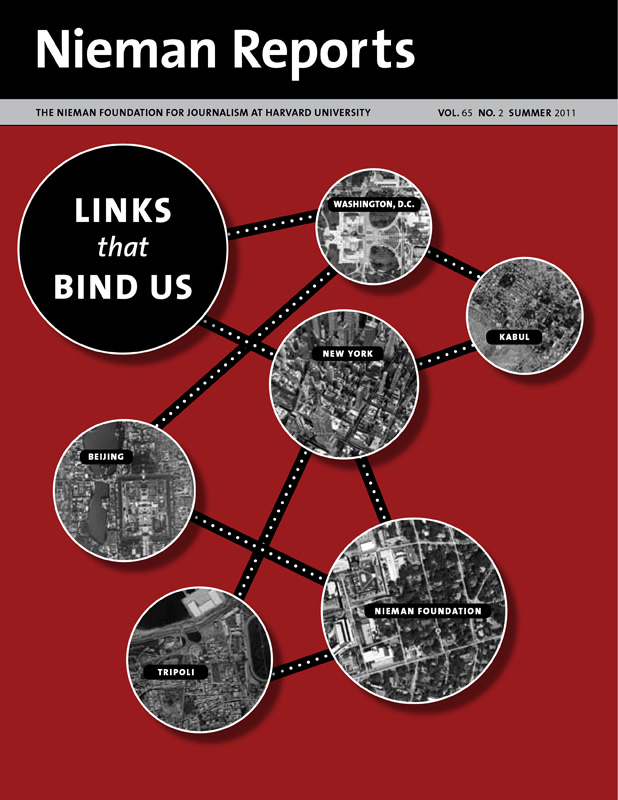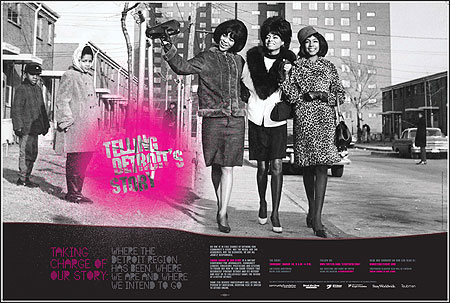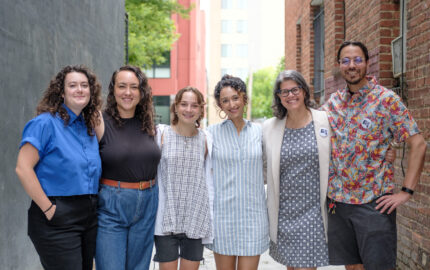
Links that Bind Us
In digital space, journalists are proving to be a powerful force in creating, nurturing and engaging communities. No longer serving only geographic zones, they confront the fragmentation of audience and the need to attract and retain “eyeballs.” Their efforts to embrace and interact with communities are fueled by an instinct to survive. Habits and hobbies, interests and values, political leanings, and sports allegiances are the grist of community formation. Discover the various roles journalists are assuming and how the links we share bind us.

“Taking Charge of Our Story,” a public forum organized by New Detroit, inspired the idea behind Detroit143. Photo of The Supremes courtesy of The Detroit News. Poster design by Story Worldwide.
RELATED ARTICLES
“A Promising Collaboration of Place, Time and Niche”
- Lynette Clemetson
“A New Partnership to Build a Common Understanding”
- Shirley Stancato
“Advertising as Storytelling—So News Stories Can Be Told”
- Kirk CheyfitzCheck in with journalists who have spent part of their careers in Detroit—there are a lot of us—and you'll often hear the phrase, "Hell of a news town!" Indeed, the Motor City is packed with the edge and drama that drives compelling accounts of politics, race, crime, corruption, sports and the highs and lows of one of the nation's most important and storied industries.
It's been 35 years, but I've never forgotten the thrill of jumping on the Woodward bus and spotting people reading my story in that morning's Free Press. In my heart, I just knew they were exclaiming to themselves, "Holy Cow!" or words to that effect.
There's still plenty of hell-raising journalism in Detroit, but as good as it is, it's not enough. These days, Detroit—as a city, as a community—is wrestling with a challenge that requires a new kind of storytelling for a new sort of news town. The U.S. Census figures released earlier this year quantify a decline—under way for decades—that is now reaching a crisis point. The Detroit envisioned a century ago for a population of two million is home to just over 700,000 people today. It's a decline that, combined with recent economic trends, has rendered Detroit unsustainable as a city with its current distribution of neighborhoods, city services, and schools.
Its mayor—former Detroit Pistons star Dave Bing—has highlighted the reshaping of the city as the most important task facing his administration and has launched the Detroit Works Project to address it. His staff has conducted a series of public meetings as part of a civic engagement effort designed to ensure that whatever plan is adopted reflects public opinion. The city has provided few details of what's under consideration, but what appears likely is a version of urban triage, aimed at stabilizing some parts of the city as others are converted from neighborhoods to urban farms or who knows what else.
The city's print, electronic and online media have produced some solid reporting on these issues and public discussions. Detroit is also home to several examples of recent media innovation, including a yearlong project by Time magazine, which bought a house where reporters in its reopened bureau lived; WXYZ-TV's creation of a Detroit2020 website focused on the city's future; and various initiatives such as Data Driven Detroit and Model D that examine the city from enterprising new angles.
Despite cutbacks, the Free Press and The Detroit News maintain the biggest newsrooms in town and lead the way in local accountability journalism. Two years ago the Free Press won a Pulitzer Prize for its game-changing coverage that culminated in Mayor Kwame Kilpatrick resigning and going to jail.
But it's not enough. The uncertain future of Detroit's 143 square miles of land and water—and of the various communities of people who live there—demand a level of focused and interactive coverage that has not yet been attempted in this city. At The Poynter Institute, where I teach entrepreneurial journalism, we urge a ruthless focus on audience needs as the sine qua non of any new venture. In Detroit, the people most affected by the city's reshaping require a steady stream of hard facts and clear analysis as they decide their future. But just as importantly, residents need to have journalism delivered as they want to consume it and in ways that will encourage them to move beyond absorbing news to acting on it.
We won't know what the audience really needs until we get on the ground and find out, but here is some of what journalism for and about this community might look like:
- Mobile apps with built-in opportunities to mobilize around key issues.
- An online game inviting players to design Detroit's future, Sim City-style.
- Lots of meetings and follow-ups at whatever public library branches remain open.
Journalism and Civic Engagement
During the past 18 months, four of us have assembled the outline for a news venture—we named it Detroit143—aimed at addressing those needs. We discovered after the fact that the numbers 143 signal "I Love You" in texting code. It's a double entendre that might seem inappropriate for a traditionally detached news organization but fits our venture just fine.
The initiative's prime mover is Kirk Cheyfitz. He and I covered the city's first black mayor, Coleman Young, in the 1970's before heading off in different directions. It was Cheyfitz's outraged reaction to a Time magazine cover story pinning much of the blame for Detroit's woes on Young that prompted him to track me down in the fall of 2009. He found me in Cambridge, where I was a fellow at Harvard's Joan Shorenstein Center for the Press, Politics and Public Policy and using my time to explore new ways to sustain local news. Just a few doors down the hall from me sat Daniel Okrent, the author of the Time story that had upset him.
I didn't share Cheyfitz's feelings about that story, but he did convince me that somebody—maybe us—should dig deeper into how Detroit ended up in such a mess and what role journalism might play in its turnaround. It was then that this effort was launched with the goal of creating new connections between what journalists can do and what people in Detroit need to push their city ahead.
Shirley Stancato, president and CEO of New Detroit, the city's leading civic coalition, joined forces with us shortly thereafter to organize a daylong conference to explore the roots of the city's problems and the sort of journalism required for its years ahead. And last summer, former New York Times correspondent Lynette Clemetson joined the team after completing a Knight-Wallace Fellowship focused on news innovation.
Together, we've been envisioning ways of linking journalism and civic engagement in ways not tried before.
Just as Cheyfitz took inspiration from Time magazine to get us started, we intend to build on the sort of innovation demonstrated by such city-focused journalism initiatives as EveryBlock, SeeClickFix and Localocracy. But technology isn't going to get the job done without the intervention and interaction of dedicated journalists and engaged audiences. So we intend to focus all three—the people, the journalism, and the technology—in undertaking the most important story in town. Doing this will cost money, which we have not yet raised. But we believe there's no better place than Detroit—and no better story than its reimagination—to get to work building a new kind of news town.
Bill Mitchell is the leader of entrepreneurial and international programs at The Poynter Institute. He worked as a journalist in Detroit for 15 years, including stints as a reporter and editor at the Detroit Free Press and a bureau chief for Time magazine.


